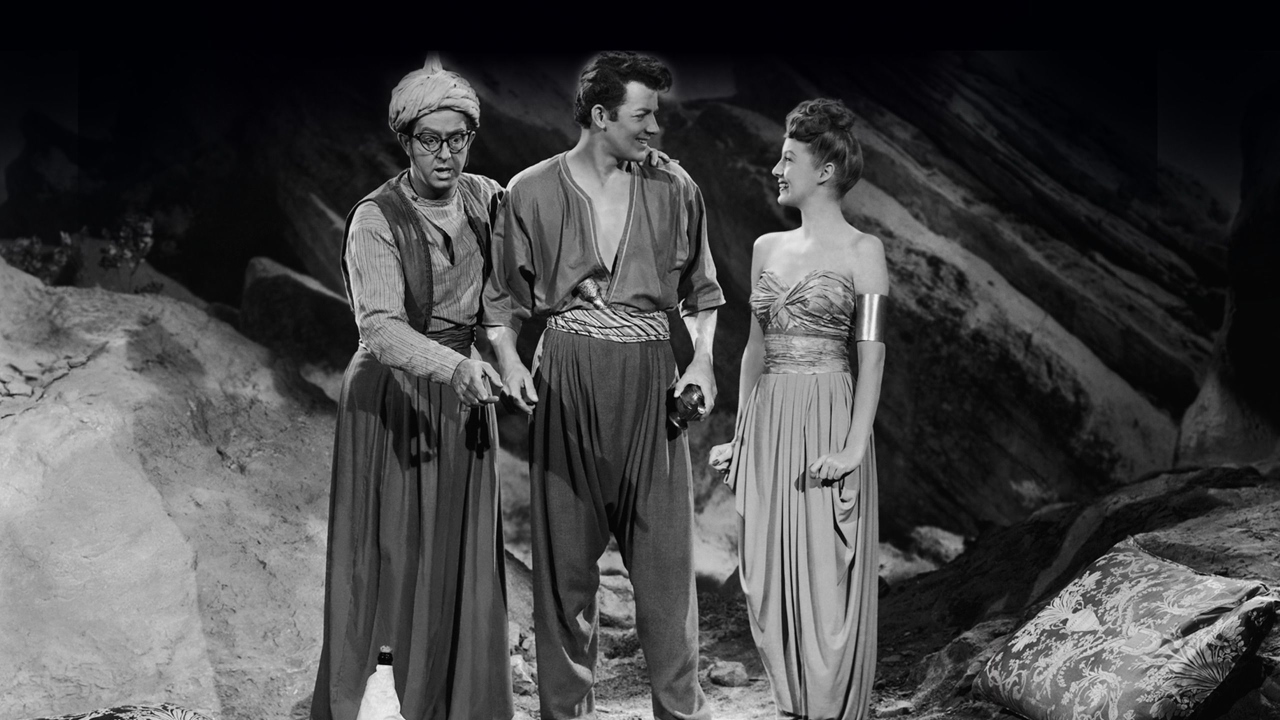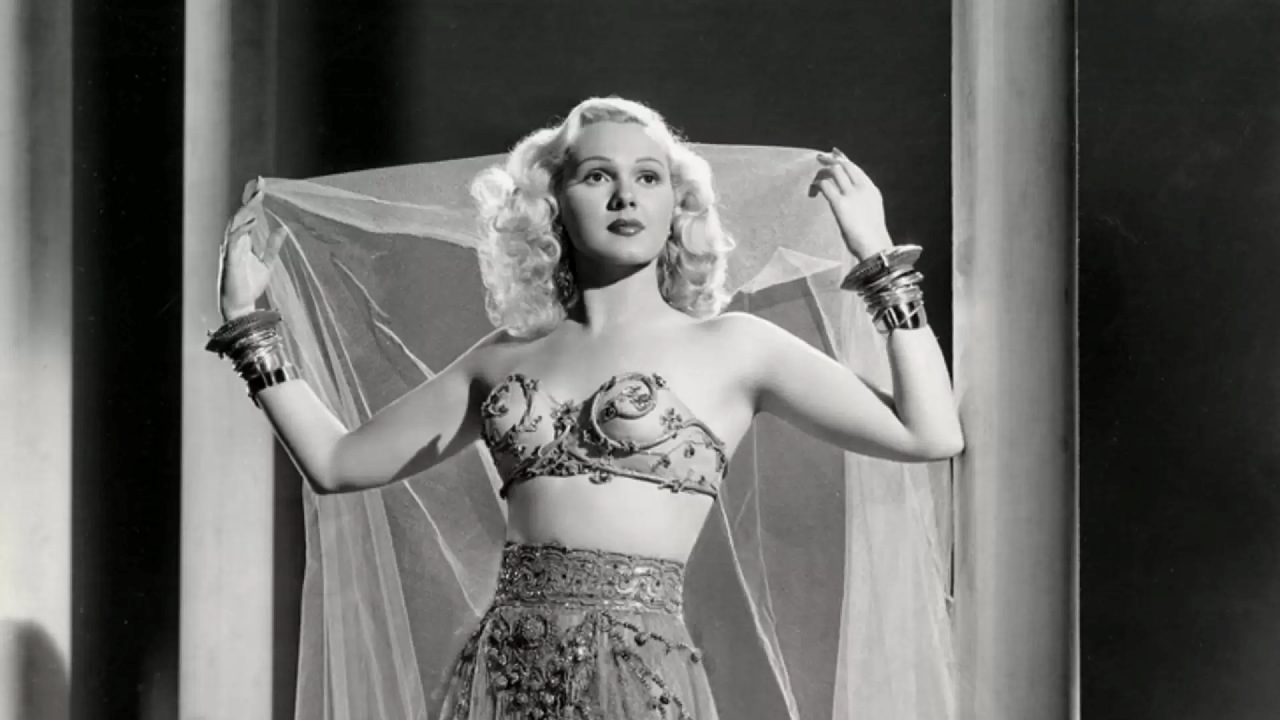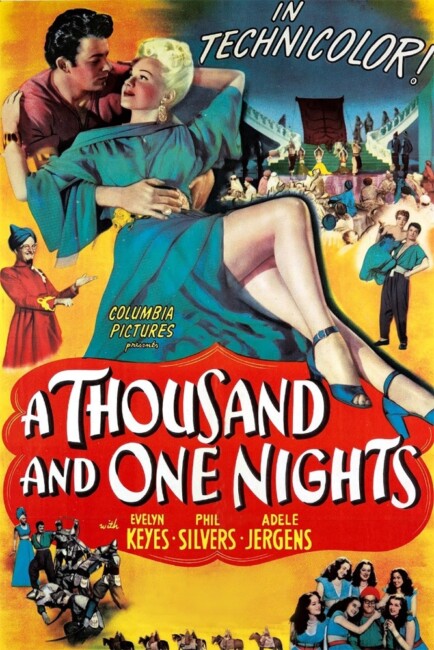USA. 1945.
Crew
Director – Alfred E. Green, Screenplay – Richard English, Jack Henley & Wilfrid H. Pettitt, Story – Wilfrid H. Pettitt, Producer – Samuel Bischoff, Photography – Ray Rennahan, Music – Marlin Skiles, Process Photography – Ray Cory, Special Effects – Lawrence W. Butler, Art Direction – Stephen Goosson & Rudolph Sternad. Production Company – Columbia.
Cast
Cornel Wilde (Aladdin), Phil Silvers (Abdullah), Evelyn Keyes (Babs), Adele Jergens (Princess Armina), Dennis Hoey (Sultan Kamar/Prince Hadji), Philip Van Zandt (Abu Hassan), Dusty Anderson (Novira), Richard Hale (Kofir), Rex Ingram (Giant), Nestor Paiva (Kahim)
Plot
Aladdin is a figure of many charms for his singing in the bazaars. One day, the entourage of the sultan’s daughter, The Princess Armina, comes past. It is forbidden to see her but Aladdin steals into her palanquin to steal a kiss from her. This leaves Armina entranced. Aladdin sneaks into the palace to see her again but is captured. He is taken before the sultan. However, the sultan has just been dethroned and is being impersonated by his no-good twin brother Prince Hadji. Armina helps free Aladdin and his wisecracking cellmate Abdullah. Aladdin and Abdullah flee the city, taking refuge in a cave. There the sorcerer Kofir persuades Aladdin that the princess could be his if he ventures into a cave and steals a magic lamp from under the watch of a giant. Aladdin and Abdullah do so but Aladdin then realises that Kofir intends to cheat them. He instead uses the lamp to conjure the flirtatious genie Babs, who can only be seen by him. He uses the power of the lamp to affect an escape and then transform himself into a great prince from afar come to woo Armina.
The Arabian Nights – or to give it its real name Alf Layla wa-Layla, which literally translates into English as One Thousand Nights and a Night – is one of the classic works of fantastic literature. In the story, the sultan Schariar has been betrayed by his wife and vows to marry a virgin each night and have her executed in the morning before she can betray him. The vizier’s daughter Scheherazade offers to marry him, telling the sultan a story each night but leaving its ending until the following night to spare her life. The Arabian Nights consists of the various tales that she tells.
The Arabian Nights was composed sometime around the 9th-10th Centuries, with the stories originating out of the Persian oral tradition. Many of the tales were added over the years and their actual number varies widely from version to version. The collection first appeared in Europe with Antoine Galland’s twelve-volume translation Les Mille et une Nuits (One Thousand and One Nights) (1704-17) where Galland adds stories that he had heard from others. There have been a number of other translations since then.
The Arabian Nights has been sporadically adapted to film. The first of these was the Hollywood swashbuckler Arabian Nights (1942). Other versions include the Japanese tv series Arabian Nights: The Adventures of Sinbad (1975); Pier Paolo Pasolini’s beautiful and erotic adult version Arabian Nights (1974), the French 1001 Nights/Scheherazade (1990) with Catherine Zeta-Jones as Scheherazade; the lush tv mini-series Arabian Nights (2000) with Dougray Scott as the caliph and Mili Avital as Scheherazade; and Arabian Nights (2015), a three-part Portuguese film that loosely conducted the story in the present day; as well as distaff animated parodies such as 1001 Arabian Nights (1959) featuring Mr Magoo and Scooby Doo in Arabian Nights (1974). Mostly cinema has been happy to appropriate individual characters and stories from Arabian Nights such as Aladdin, Ali Baba and Sinbad, who have all undergone numerous individual screen adventures, or else borrow the generic milieu as a fantasy setting.

A Thousand and One Nights was made amid a popular fad for
Arabian Nights films in Hollywood in the 1940s. This was sparked by the success of the second version of The Thief of Bagdad (1940). This led to a number of imitators with the likes of Arabian Nights, Ali Baba and the Forty Thieves (1944), Kismet (1944), Sinbad the Sailor (1947), Bagdad (1949), Flame of Araby (1951), The Prince Who Was a Thief (1951), Son of Ali Baba (1952), The Thief of Damascus (1952), The Golden Blade (1953), Siren of Bagdad (1953), The Veils of Bagdad (1963), Kismet (1955), Son of Sinbad (1955) and The Wonders of Aladdin (1961), even the comedies Babes in Bagdad (1952) and Bowery to Bagdad (1955). Most of these ended up being dull adventure films or historical swashbucklers with the addition of a romantic element but played down the fantasy elements of the original stories.
A Thousand and One Nights throws out any allegiance to The Arabian Nights, apart from a brief mention at the start “Many years ago in Baghdad, a maiden postponed her execution for “a thousand and one nights” by telling a sultan a different story every night. If the old gal were still telling them, that latest would go something like this.” What should be mentioned is that the story of Aladdin, which the film tells, is one of the later additions to Arabian Nights that was added by French translator Antoine Galland, which he had heard it orally recounted by a Syrian storyteller.
As always with these 1940s Arabian Nights films, the casting is absurd when you look back at it from a modern perspective. Adele Jergens’ blonde-haired, pearly white skinned princess is about as far away from anything Arabic or Middle Eastern than you could care to think. Cornel Wilde was a popular actor of the day – he was nominated for an Academy Award the same year as this for playing Chopin in A Song to Remember (1945). He had a successful career and went on to direct several films, most famously the survival film The Naked Prey (1966) and the environmental collapse SF film No Blade of Grass (1970). In the film, Wilde has a habit of introducing himself as Aladdin of Cathay. The screenwriters seem unaware that Cathay was actually the name used for China in the Middle Ages so in theory Aladdin should be portrayed as Asian.

What does kill a good deal of A Thousand and One Nights is its playing as a comedy. There is the character of Abdullah, which consists of Phil Silvers wearing an anachronistic pair of gull wing glasses, who has been written in as sidekick to Cornel Wilde’s Aladdin. Silvers, who was popular comedian of the day, has been given a series of grating one-liners and cracks them at every opportunity. Not to mention these are hugely anachronistic lines – references to such things as gin rummy, television and the Waldorf Astoria. In many ways, this is a prefigural of the treatment of the same story in Disney’s Aladdin (1992) where Robin William’s wisecracking genie dropping anachronistic one-liners seems to have been directly modelled on Silver’s performance here.
A Thousand and One Nights is certainly a reasonably lavish production in terms of the sets and costumes. Unlike most of the other films of the 1940s Arabian Nights cycle, this does not tone down or remove the fantasy elements. Babs, played by the top-billed Evelyn Keyes, who was then mostly known for a supporting role in Gone With the Wind (1939), is an unusual take on the genie character. She is flirtatious and makes no secret of wanting Cornel Wilde’s Aladdin, while in later scenes she actively sets out to sabotage his marriage to Armina so that she can have him for herself.
Aside from the lamp and genie, there is also a sorcerer. The most fantastical scenes are those that take place in the cave with Cornel Wilde and Phil Silvers ducking around avoiding capture by a giant (some not bad process photography). In the most overt homage to the 1940 The Thief of Bagdad, the giant is played by Rex Ingram, who played the same role there. These elements make A Thousand and One Nights more of a fantasy than the other films in the 1940s Arabian Nights cycle that were no more glorified romantic pseudo-historical swashbucklers.
Alfred E. Green (1889-1960) directed over a hundred films from the 1910s to the 1950s in numerous different genres from dramas to Westerns to musicals. He made one other genre film with Invasion USA (1952) about an imagined nuclear attack on the US.
Full film available here


